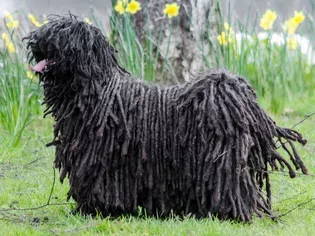Puli: Dog Breed Characteristics & Care
Updated on 05/26/24

Puli: The Mop-Haired Hungarian Sheepdog
Introduction
The Puli, a unique and distinctive Hungarian herding breed, has captured the hearts of dog enthusiasts worldwide with its mop-like coat and playful demeanor. This breed, known for its intelligence, agility, and unwavering loyalty, makes an excellent companion for active families and experienced dog owners. In this comprehensive guide, we'll delve into the intricate world of the Puli, exploring its breed characteristics, care requirements, and the unique bond it shares with its human family.
Breed Characteristics
* Appearance: The Puli's most striking feature is its long, corded coat that resembles dreadlocks. This coat, which can reach up to 12 inches in length, provides excellent insulation and protection from the elements. The Puli's body is compact and muscular, with a height ranging from 16 to 18 inches and a weight between 25 to 35 pounds.
* Temperament: Pulitas are highly intelligent and eager to please, making them responsive to training. They are playful and affectionate with family members, but can be reserved around strangers. Their herding instincts make them excellent watchdogs, but proper socialization is crucial to prevent excessive barking.
* Health: Pulitas are generally healthy dogs with a life expectancy of 12-15 years. They are prone to certain health issues, such as hip dysplasia and eye problems, so regular veterinary checkups are essential.
Care Requirements
* Grooming: The Puli's unique coat requires meticulous grooming. Regular brushing is essential to prevent matting, and professional grooming every 4-6 months is recommended to maintain the coat's corded appearance. Bathing should be done only when necessary, as excessive bathing can damage the coat.
* Exercise: Pulitas are active dogs that require daily exercise. A combination of walks, playtime, and interactive games is ideal for keeping them physically and mentally stimulated. Proper exercise helps prevent boredom and potential destructive behaviors.
* Training: Early socialization and training are crucial for the Puli's development. They respond well to positive reinforcement and reward-based methods. Patience, consistency, and positive guidance are key to creating a well-behaved and obedient Puli.
* Nutrition: Pulitas require a high-quality diet that meets their nutritional needs. Consult with your veterinarian to determine the appropriate food and feeding schedule for your dog.
Unique Bond with Family
The Puli forms an unbreakable bond with its family. They are loyal, protective, and eager to please their owners. Pulitas thrive on companionship and enjoy participating in family activities. Their playful and affectionate nature makes them excellent playmates for children, and their watchful instincts ensure the family's safety.
Examples: Personal Experiences
* "My Puli, Zara, is the most affectionate and playful dog I've ever had. Her corded coat is a showstopper, but it's her silly personality that steals my heart."
* "I've owned my Puli, Zeus, for over 10 years, and he's been an incredible companion. His intelligence and eagerness to please make training a breeze."
* "My family loves our Puli, Mia. She's a great watch dog, keeping us safe and alerting us to any strangers or unfamiliar sounds."
Conclusion
The Puli is a remarkable breed that combines unique characteristics, care requirements, and an unwavering bond with its family. With its intelligence, agility, and playful demeanor, the Puli makes an exceptional companion for those willing to embrace its unique grooming needs and provide the necessary exercise and training. If you're seeking a loyal, affectionate, and distinctive canine friend, the Puli may be the perfect breed for you.
Explore More Pets

Basic Training
Puppy and Baby Introductions

Working Dog Breeds
All About Search and Rescue Dogs

Dog Treatments
Puppy Vaginitis: Signs, Causes and Treatment

Dog Adoption
After More Than 1,200 Days in the Shelter, Coco Goes Home

Basic Training
How to Train Your Puppy to Go on Potty Pads

Hybrid Dog Breeds
The Difference Between a Mutt, Mixed Breed, or Designer Dog?

Dog Treatments
Nail Problems in Dogs

Puppies
7 Reasons Why Two Dogs Are Better Than One
